The marketing mix is how we build our marketing strategy. It is the elements and ingredients that we need to successfully address the needs and wants of our customers.
Ultimately, the it’s the foundation of marketing. Its understanding helps us to craft a better strategy and build one which allows us to better serve our customers.
Here, we are going to look at an overview of the marketing mix.
What is the Marketing Mix?
It is the mix of elements that marketers have at their disposal to formulate a marketing strategy to reach their target market.
In the earliest references to a “marketing mix” in the 1940s, Professor James Culliton called marketers “mixers of ingredients”. These ingredients would later become the formal marketing mix. And the mix of ingredients is the embodiment of the definition of marketing. Which marketing is getting the right product in front of the right market in the right place at the right time.
This has become the foundational model to marketing strategy and execution. It’s been presented in many models. The 4Ps marketing mix has become the most widely accepted model. Two other models that have been widely accepted are the 7Ps marketing mix and the 4Cs marketing mix.
In understanding the marketing mix, we will look at the three most widely accepted models.
The 4Ps Marketing Mix
The first marketing mix model we will address is the 4Ps marketing mix.
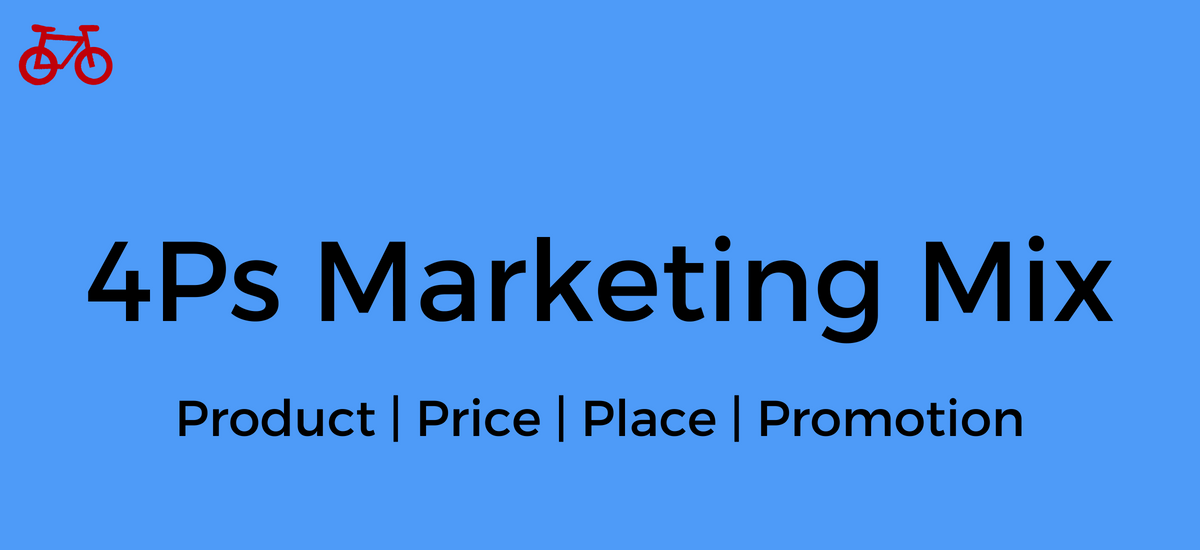
The 4Ps of marketing are product, price, place, and promotion. This is the framework most commonly used to ensure we are effectively marketing our products. It represents the definition of marketing. It is a simple and effective formula, which we can follow in most cases.
It is these four P’s, that when applied to our marketing, provide the necessary framework to build an effective strategy. A strategy that ensures we are getting our product to the right customers at the right time.
The following are the 4Ps and a brief definition.
Product
A product is a good or service that satisfies a need or want of a target market.
A product is a solution to a markets problem. Which, can come in the form of a physical good, a digital product, or a service.
Another way to define a product is with Kotler and Armstrong. They say a “product means the goods-and-services combination the company offers to the target market”.
Price
Price is what customers pay for a product or service. It is a measure of the value placed on a product, both by the buyer and the seller.
Price is a key component. Being one the most direct ways of communicating value to a customer. Also, price is the one component that has a direct impact on a product or companies’ revenue and profitability.
Thus, pricing is the act of determining the price of a given product or service. Using the marketing mix and various pricing strategies and tactics to accurately convey the value of a product or service.
Place
Place, is the movement of a producer’s goods to the producers intended user. It is the distribution of your products within the market.
Place can also be called placement or distribution, but all three terms are referencing the same component.
Another way to think about place is that it is the point of sale.
Place encompasses everything about distributing your product to your users. That means channels, inventory, logistics, market coverage, location, and transportation.
Promotion
Promotion, as it relates to the marketing mix, is all the communication activities a company performs to inform its customers and prospective customers.
Promotion is how companies establish their brand, the company voice, communicate features and benefits, build awareness, and persuade customers and prospective customers.
Since promotion is everything to do with communication, it is often referred to as marketing communication. Thus, the mix of activities may also be referenced as the marketing communications mix.
Promotion is an essential component of the marketing mix and it contains its own set of components.
These are the 4Ps of marketing and their definitions. Within each of these components of the marketing mix, we can build our specific strategies and tactics.
The 7Ps Marketing Mix
The next marketing mix model we will take a look at is the 7Ps marketing mix.
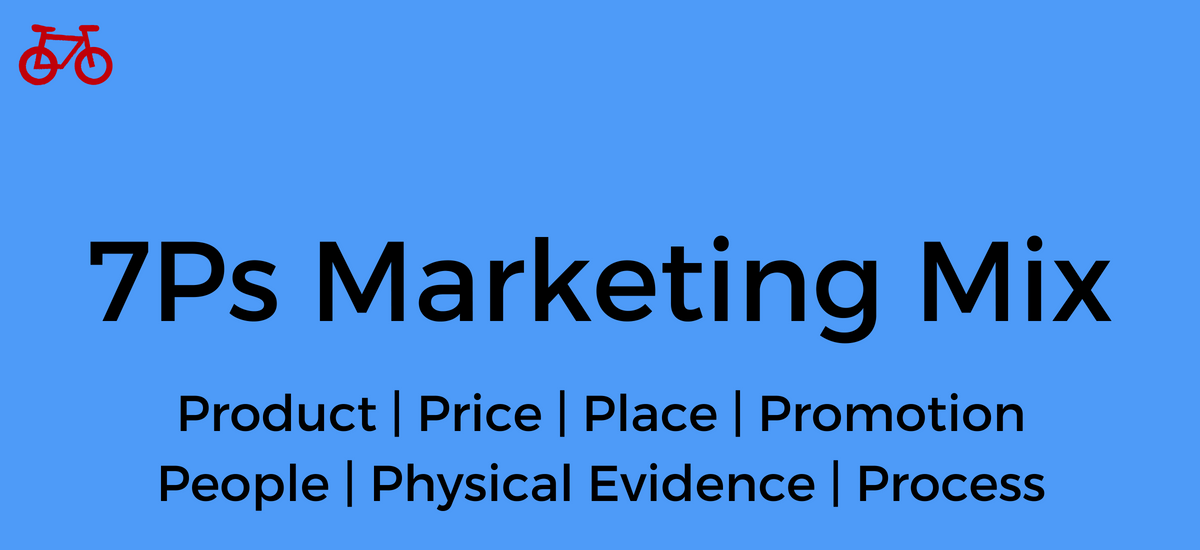
The 7Ps of marketing is an adapted marketing mix theory, which has gained significant traction. It takes the original 4Ps marketing mix and expands the model to address additional marketing concerns for a business.
The 7Ps model contains the original 4Ps, which are product, price, place, and promotion. Then adds three additional Ps, which are people, physical evidence, and process. It is usually associated with being applied to service businesses, but there becomes increasing crossover for its application to many other types of business.
It was primarily formed as a response to the characteristics of a service business. Which state that service products lack ownership, they are intangible, experiences need to be consistent, services are perishable, and they are produced and consumed at the same time.
The additional Ps of the 7Ps of marketing are as follows.
People
People, in the context of the marketing mix, are all the people within your organization. This includes employees, management, customer service, and the overall company culture. The focus of the people component tends to be the customer centric employees of the company. This is usually the outward facing employees.
Such as, sales representatives, customers service, and management.
The most common framework where people is included is in the service marketing mix. This is applying the marketing mix to service companies, where people are an essential component of the product.
Physical Evidence
As a component of the marketing mix, physical evidence is the location and environment where the customer purchases and/or consumes the product. It is the environment where the company and customer interact in the exchange of the product.
Originally, this was most pertinent to service products, but the lines have become blurred between service products and physical products. Companies of both service products and physical products want to control the physical evidence of the product, as it contributes to the overall customer experience.
Physical evidence is a way to control and add value through the presentation of intangible elements of a product.
Process
Process, as a component of the 7Ps marketing mix framework, is the component of the marketing mix that deals with delivery of the company’s product. It is most pertinent to the delivery of service products.
Process encompasses all aspects of service delivery, customer service, as well as the overall customer experience.
Essentially, process is concerned with how you deliver your product to the customer. Then, how you handle servicing the customer during the use of your product.
These are the three additional Ps that make up the 7Ps of marketing. Whether a product or service, you can decide if the expanded model is right for you.
The 4Cs Marketing Mix
The third marketing mix model we will address is the 4Cs marketing mix.
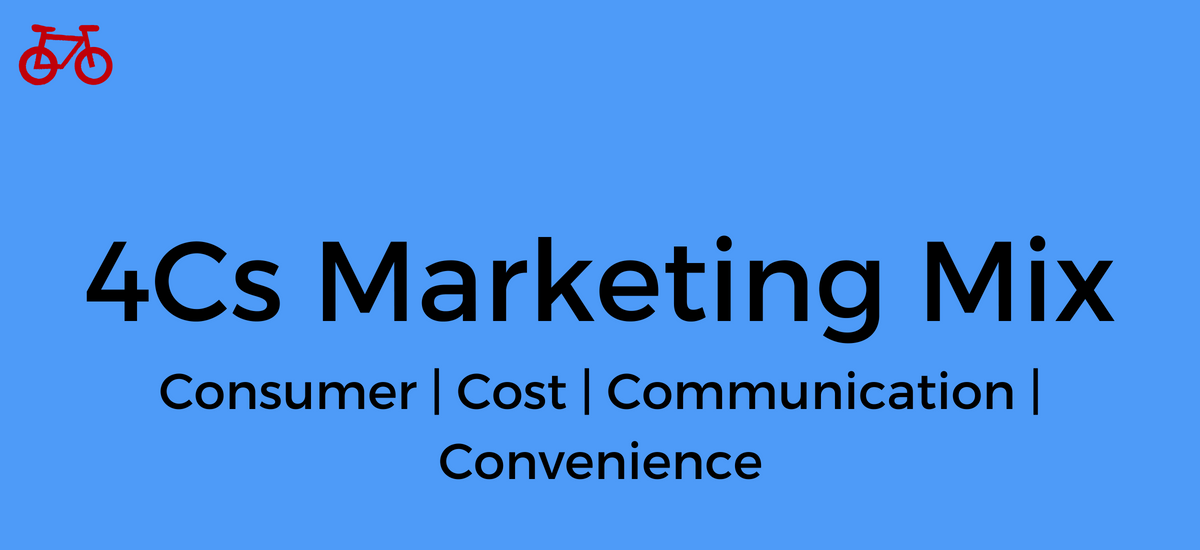
The 4Cs marketing mix elements are consumer, cost, communication, and convenience. This is the marketing mix strategy, which is one of the more widely accepted strategies for ensuring that the customer is the focal point.
It is a modern adaptation of the 4Ps of marketing. This version of the marketing mix takes the 4Ps model and makes the customer the center of the marketing mix strategy. The purpose of the strategy is to put the customers interests ahead of the company’s.
This is reflected in the fact that the theory uses “Cs” as the elements in its name structure. Also, every element we use in this model is focused on bringing value to the customer.
Customers are an essential component to our business. Thus, we need to consistently do actions that make sense to the customer. Which is how the 4Cs of marketing came to be.
The elements of the 4Cs marketing mix are as follows.
Consumer
Consumer, or the customer, is the individual who uses your product. In the 4Cs marketing mix, the consumer is the first C. It establishes that all marketing should be customer focused and the first C is about providing a product strategy that is customer centric.
With consumer, marketing and product development begin their process with customer needs and wants. Then, based on the customer, a company will only build products that customers want.
This process requires a deep understanding of your customer and their journey. Then, with that understanding, you can make educated product development choices and create products that customers ultimately want.
The consumer is the center of the product strategy.
Cost
Cost is the concept in the marketing mix that looks at the cost of acquiring and using a product from the customers perspective. It includes every aspect of cost that a customer may face when using your product.
The cost component can include things like the price, the cost of switching, the time it takes to learn a new product, and any ongoing maintenance costs. Cost creates a holistic view of the customers perspective for acquisition and use of your product.
Ultimately, cost is a about the total cost of ownership of a product.
Communication
Communication is the process by which a company communicates with their customers.
As a component of the 4Cs marketing mix, it doesn’t only include the traditional one-way communication flow of promotion. It also includes the concept of two-way communication with customers.
Thus, communication is the push communication to customers regarding promotions and product information. Also, communication is the feedback communication that a company receives from their customers.
It is this complete communication loop that communication in the 4Cs marketing mix addresses.
Convenience
Convenience, as a component of the marketing mix, is how convenient it is for a customer to purchase, acquire, or use a company’s product.
Convenience addresses all aspects of the buying experience. That includes finding information about solutions to the customers need. Evaluating solutions and comparing them. As well as the act of purchasing. Convenience is concerned with making each step as easy as possible.
Using convenience as a marketing mix component helps address not only where a product is placed or its distribution, but allows us to address all aspects of making our products convenient for our customers to purchase.
The 4Cs of marketing and understanding what they are and how they interact with the marketing mix, allows us to have an overview of this theory of the marketing mix. It is all about keeping the customer at the center of our marketing strategy.
The History of the Marketing Mix
The history of the marketing mix is not one where the final model was proposed and then used. It progressed over time and did not reach a consensus until long after the concept had begun to be used.
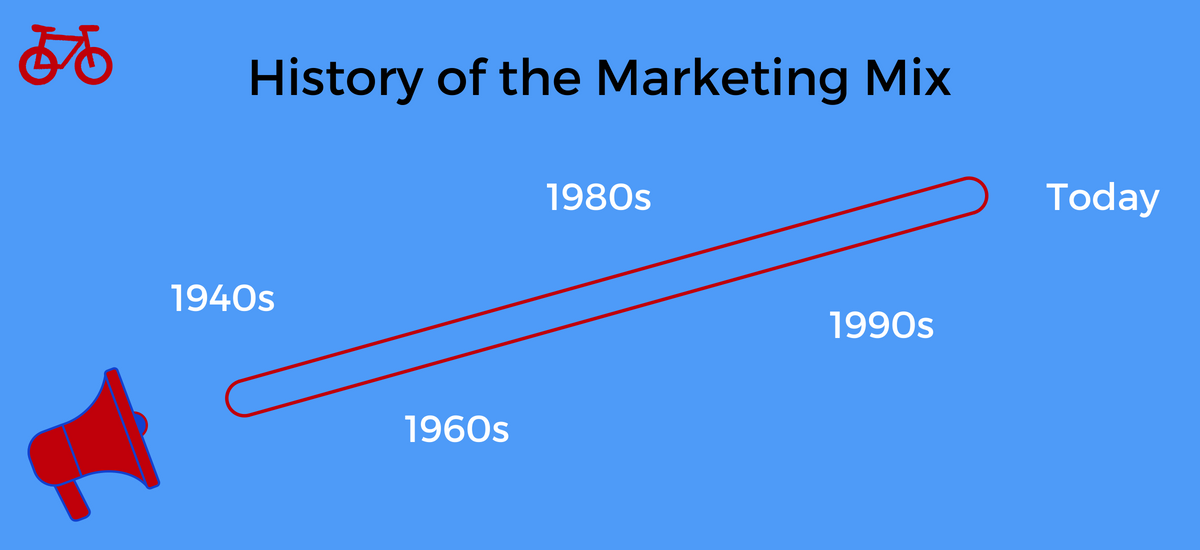
The origins of the marketing mix begin as early as the 1940s when Professor James Culliton of Harvard University began referencing the idea of a “marketing mix”. This was the idea used as Professor James Culliton would reference marketers as “mixers of ingredients”. Thus, the idea of the marketing mix was born.
It progressed through the 1940s and 1950s and Professor Neil Bordon, who was a colleague of Culliton, also began to use the term in marketing papers that were published. Bordon is known to have used the term during an address to the American Marketing Association.
As the term “marketing mix” was being used, and the concept of marketers being “mixers of ingredients”, the elements were not established until much later.
It was not until 1960 that all the theories and discussing around the marketing mix were developed into the concrete 4Ps of marketing we commonly use today. In 1960, E. Jerome McCarthy proposed the 4Ps theory of product, price, place, and promotion. It was then that there was a consensus on the elements.
Once this was established, Philip Kotler began to popularize this model of the marketing mix, which is the most widely accepted today.
Although we arrived at the 4Ps of marketing in the 1960s, further models were developed. In the 1980s and the 1990s we had the 7Ps marketing mix and the 4Cs marketing mix theories developed.
The 7Ps model, which we discussed earlier, was developed as a reflection back to the original marketing mix discussions. In the original discussions, there were twelve different elements being considered.
Those twelve were eventually condensed to the final 4Ps model. But, if we consider that there were twelve that were originally being considered, that means there were some essential pieces being left out of the mix.
This is where the 7Ps marketing mix decided to address these concerns. By adding people, process, and physical evidence to the marketing mix, they were addressing concerns of many service businesses.
The evolution of the marketing mix does not stop there. In 1990, as a professor at the University of North Carolina, Bob Lauterborn believed the 4Ps marketing mix was no longer applicable. To the point where he believes the model should be thrown out. And as we throw out that model, we replace it with the 4Cs. A customer focused model.
The proposal came from the shifting needs of consumers in the 1980s. MBA students were learning the 4Ps model, which was developed in the post-war mass marketing boom. Thus, the 4Cs model focused on creating more niche products to better satisfy the needs and wants of consumers.
The 4Cs came as the culmination of Lauterborn thinking the customer was not successfully being addressed. And therefore, we place the customer at the center of our marketing strategy.
This is a brief history of the marketing mix. Which to fully understand the history of this theory, we need to look at the complete history. But, with this understanding, we can understand why there is a marketing mix.
Understanding the history and the why, helps us to better formulate our own marketing mix strategies.
How to Use the Marketing Mix
Theories are useful, in that they help form the foundation for the strategies we choose. But, moving from theory, to strategy, to execution is never easy. That is why after looking at a specific theory, we need to figure out how to apply it.
This is no different in the marketing mix.
The ingredients that marketers use to build their strategy. These ingredients are the pillars for the questions we ask ourselves about our business. Then, we look at the components of each pillar. Lastly, we make all that work together as one cohesive unit.
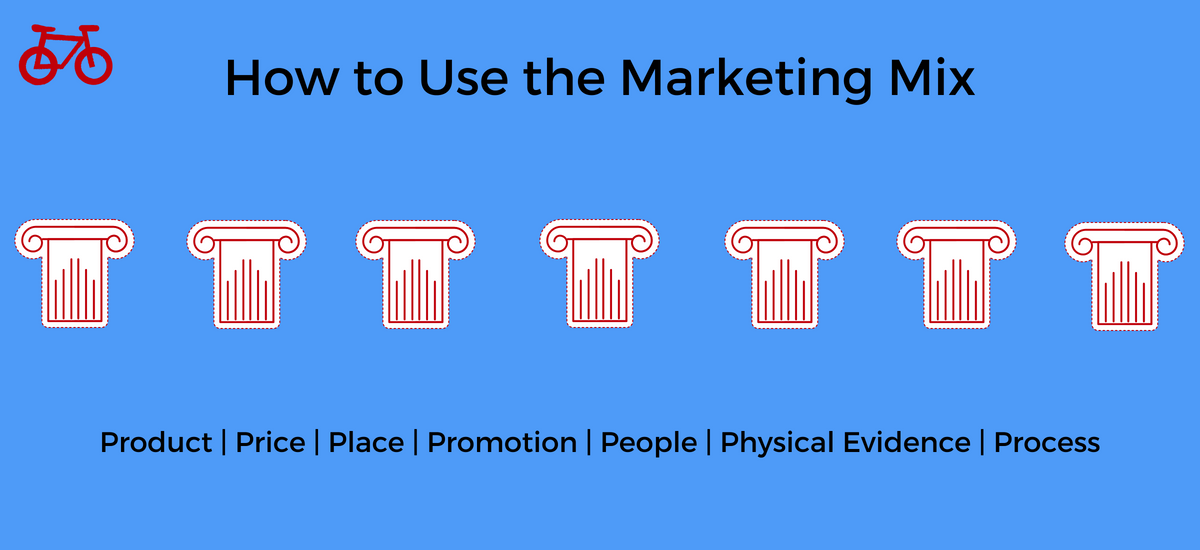
That sounds simple enough. But, we need to look at it in a bit more detail. So, as an overview for executing the marketing mix, here are some questions we should ask in each of the components.
The Product and the Consumer
Building and defining our products is the foundation. But, we need to also address products that our customers want and need. Some of the product component questions we should ask are as follows.
- What is the market need?
- What problem do my customers have that I can solve?
- What is my product?
- How do I develop my product?
- What are customers’ needs or wants?
- What product can solve our customer needs?
These are just a few of the questions to consider when planning the product component.
The Price and the Cost
Price, and the cost to our customers, is one of the most difficult components, and takes a lot of work to get right. Some of the questions we should ask are the following.
- What will my customers pay?
- What are my costs?
- What should be my pricing model?
- What should be my price?
- What is the total cost of ownership?
- What is the value we bring to our customers?
The questions here are an easy starting point when looking at price.
Place and Convenience
Place, and the convenience of acquiring our product, which is how we get our product in front of our customers, looks primarily at distribution. Some of the questions we should consider are the following.
- Where do our customers want to purchase our product?
- How do customers want to purchase our product?
- How should we distribute our product?
- What is the most convenient way for our customers to use our product?
- Where is the most convenient place to acquire our products?
There are many distribution and logistics concerns we need to address in the place component. These are a few introduction questions we can ask ourselves.
Promotion and Communication
Communicating with our customers is an important element. If our customers and target market are unaware of us, then we cannot get our product in front of them. Thus, here are a few of the questions we need to ask.
- How should we communicate with our customers?
- What communication channels do they prefer?
- What story will resonate with customers?
- Can we offer incentives to purchase?
- How can we start a two-way conversation?
As we look at promotion we have to consider our message, how we communicate, as well as any incentives we offer. These are questions to get started with the promotion component of the marketing mix.
People
The team we build to interact with our customers is an important element. We should consider the following questions.
- Who should we hire?
- How should our people act?
Process
The process by which we deliver our product ensures consistency and efficiency to our customers. A few considerations to make are the following.
- How should we ensure consistency?
- How should we deliver our product?
Physical evidence
The environment that our customers consume our product is important. It consists of all the intangibles with our product. Some of the considerations should be the following.
- What should the environment be?
- How do we intangibly communicate value?
Using the marketing mix is far more important than discussing it. This is an overview to get started using it as a guiding framework for your business. But, there are far more sophisticated ways to use these theories. Understand the basics, then incorporate a more complex approach to your strategy.
The marketing mix is the foundation to our marketing strategy and marketing plan. Having a deep understanding of its elements, and why and when we should use each one, gives us the ability to make better decisions. This is an overview of the few different models, and how we can use them.
